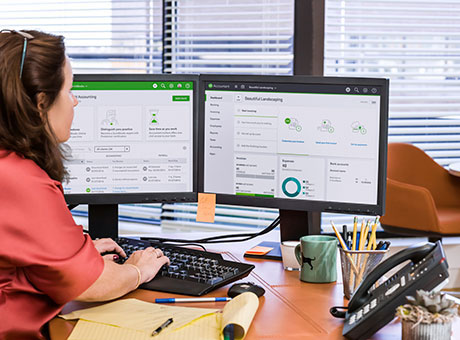Budgeting is one of the core functions of running a small business, but one aspect of sound budgeting sometimes goes overlooked: forecasting. Forecasting is the art of accurately predicting your future revenue and expenses to make informed business decisions. But budgeting and forecasting aren’t exactly the same, and understanding the differences between the two helps for future planning. Running a budget uses information you already have to find out how you’re doing now, while forecasting uses reasonable estimates from past performance to predict future revenues. These related techniques draw a lot from each other, and honing your skill at one often translates into skill at the other.

Formulating and Forecasting a Yearly Budget
How Do Budgets and Forecasts Differ?
Budgets and forecasts are financial planning tools that help you make decisions regarding your small business. Although these two methods sometimes overlap when you’re analyzing an aspect of your business, they’re two completely different ways to strategize and plan. Both tools rely heavily on estimation, especially forecasting, but the scope of each tool is different.
Characteristics of a Budget
When you prepare your budget, you’re devising a plan for the direction of your business. It’s a tool that lets you control the activity of your business, so day-to-day operations and spending occur where and when you choose. Once you have a handle on the market, you use your budget to make a plan for upcoming periods. Your budget serves as a control against spending. A forecast serves as a measure against your idea of where the market is headed and your place within it.
When you begin your company’s budgeting process, you start first with your sales budget. You start there because the information from your sales budget is critical to formulating all other budgets within your company, including marketing, purchasing, and production. The sales budget is the foundation of your company’s financial plan, which dictates how you should allocate resources to achieve your revenue objectives.
Characteristics of a Forecast
A forecast is different than a budget in the sense that you’re estimating, based on the market and your current budget, where your business is headed, regardless of what you might desire. Industry trends and market outlook strongly influence a forecast. It’s also highly contingent on customer spending patterns, your company’s anticipated growth, and other external factors you have no control over, such as politics, current events, and even the weather. For instance, if record snowfall is anticipated next winter, your snow removal business forecasts higher sales. This forecast provides you with valuable information to use as you develop your budget for that season.
Forecasting sales is the most important element of creating your sales budget. Sales forecasting relies on marketing and industry data, historical trends, competitive analysis, economic forecasts, and statistical trend analysis. Once you develop initial forecasts, analyze them for adjustments based on strategic variables, such as your projected customer growth, product and pricing changes, promotional plans, discounts, events, and staffing or operational changes. Once you collect and process all of the data, you can establish a final sales forecast, which you communicate back down the chain.
Comparing Budgets and Forecasts
Say your business hopes to earn $300,000 in total revenue net year. First, you perform a forecast by analyzing company growth, industry trends, and market possibilities. After analyzing, you might discover your revenue is only going to reach about $200,000. Then you incorporate this forecast into your company’s budget.
Now you have relevant information to build your budget upon. If you use a sales revenue amount of $300,000, your subsequent budget is useless because your plans don’t match the operating results. Instead, by using proper data, your forecast translates to more relevant and useful information.
Direct Differences
Both your budget and your forecasts are fluid tools. Updating your forecasts frequently helps you adapt to new market conditions and variables. You might refer to previous forecasts for process improvements and ideas, but a forecast is usually only forward-looking. A budget relies heavily on past results. Both incorporate historical figures, but your budget retains those figures. Your forecast adapts them to form expectations.
Variants of Reports
Both tools can be developed in a number of ways, further blurring the distinction between a budget and a forecast. A budget can be static and unchanging. You can also adjust it throughout the year by using a flexible budget. You can perform your forecast using an average approach, drift method, time series methods, or econometric models. Your budget and your forecast can be rolling – a method of adding an additional period at the end of the report as the current period ends. Still, the general principle remains for all items above: A budget allocates and plans for the use of resources, while a forecast identifies what those resources are.
When You Should Use a Forecast
There are specific times and situations in which you use your budget and others where you look to your forecasts for future planning.
At the launch of a product…
You definitely need an accurate forecast during the run-up to a new product launch. This could be a frenzied time for your business. An unsuccessful launch can be a real problem, especially if you’ve put most of your eggs in one basket. Accurately predicting market and consumer conditions in this case can help during your planning and execution stages.
Say you’re planning to roll out a new kind of tongue depressor, hoping it takes the medical supply field by storm. But it requires a third of your budget to bring the product to market. If you’ve prepared reliable forecasts based on previous successes with this type of rollout, existing demand for your new model, the popularity of competing models, and a clear picture of how much end users are ready to pay for the product, then you should have a notion of how long before you realize a profit, however small. That information can drive you to go ahead with the launch on schedule, take out a business loan as a buffer zone for the slow growth you expect, or delay the launch until quarterly profits are in and you’ve got a bit more money in the bank.
For rainy days…
Businesses have their ups and downs, and small businesses like yours feel the tight times more than large corporations. Riding it out when things are slow can be difficult, but it’s even harder to plan realistically for the good times ahead when all you can see in a recession is miles of dark tunnel ahead. If you can forecast the return of boom conditions in your industry, you’ve got a critical leg up during your roughest times.
For instance, if your company distributes soy to Argentina, you might have it rough when the price of beef falls in the Pampas. Your company, and all the other international soy distributors, may be hurting. Forecasting the end of the slump gives you a chance to invest in new infrastructure and hire new drivers a few weeks or months before prices shift and your business picks back up – all of which is part of truly knowing your market and industry and the many outside variables. It’s important to be a quick study and learn what trends affect you, how they affect you, and what you can do when the going gets tough.
When giving vacation time…
Forecasting is helpful on a much smaller scale than import-export soy futures. As a business owner with employees, you know there are good times for workers to take vacations and times when it’s not feasible to be shorthanded. Reliably forecasting those cycles helps balance the company’s need for productivity with workers’ needs for suntans on the beach.
Say you have a holiday-heavy business such as licensing the rights to popular Christmas carols. You’re probably going to be busy in November and December, with a bit of slack starting in January. If you understand this annual cycle, you can schedule your hiring, layoffs, vacations, and training cycles for when they’re most advantageous.
Budgeting and forecasting are both vital skills for a small business owner to master. Accurate forecasting gives insight into likely future events and confers a potentially decisive advantage to your company.
The Importance of Accurate Forecasting
If you’re able to forecast your company’s future sales accurately, you can create a solid budget. Of course, it’s not a science exactly, but using your company’s past sales figures and thoroughly researching your estimations leads your business to realistic future predictions. Some of the aspects of forecasting accuracy include:
- Your company’s sales figures month by month for past years
- New clients you’ve obtained and clients you’ve lost, and
- Predicting market, industry, or economic changes
If your company is rather new, conducting this research can prove beneficial in the long run. It’s helpful to know your industry and other interconnected industries. Identify the businesses in your region that are similar to yours, and take the time to analyze their sales. When are their slow times? Busy times? Is there a period during the year when they close up shop? Stay open later hours? Knowing these details arms you with knowledge you can apply to your business.
Having an idea of what you can expect in revenue and expenses is the backbone of your yearly budget , which means the accuracy of your forecasting is all the more important. Here’s where you’ve got to be honest about your current budget. Are you meeting goals you’ve set? Could your business use a bit of fine-tuning? If you create your yearly budget in QuickBooks, you always know where you stand.
It also means keeping up with the latest innovations and challenges within your particular field, including new disruptive technology, risky supplier costs due to weather or unrest, or an addition of regulations that affect the way you do business. To keep your business safe, err on the side of caution when estimating your potential ups and downs. In other words, stay conservative when counting on potential profits and liberal when planning a cushion for potential expenses.
Laying Out Your Master Budget
A small business master budget includes both operating and financial budgets, and you need both to ensure your small business can survive and thrive throughout the upcoming year. Your operating budget is comprised of your company’s income statement, showing income-generating areas of your business and including both revenues and expenses. By comparison, your financial budget is comprised of your cash budget, figuring cash, and asset inflows and outflows. You should prepare your operating budget first, then use the data projections and assumptions to create your financial budget.
Your Operating Budget
When you formulate your operating budget, eight key elements work together to paint a picture of your business’s financial situation. Keep these points in mind:
- Use sales forecasting to create a sales budget that incorporates data forecasts, managerial input, and upcoming events with the potential to impact your sales.
- Set your production budget to meet the inventory requirements of your projected sales budget, but keep in mind that service-based businesses don’t typically use this schedule, as they don’t produce actual goods or keep inventory.
- The direct materials purchases budget includes the raw resources needed to keep your business on track.
- The direct labour budget includes employee and staffing costs.
- Your overhead budget displays fixed and variable costs, such as mortgage payments and utility bills.
- Your ending finished goods inventory budget gives everything produced by your company a value based on the costs that went into it, including raw materials, direct labour, and overhead expenses.
- The selling and administrative expense budget factors in indirectly related costs, such as office supplies and shipping or freight bills.
- All these different budget schedule help to formulate your company’s income statement.
Keep in mind that your operating income doesn’t equal your net income, as it doesn’t factor in interest costs or taxes.
Your Financial Budget
Three elements make up your small business’s financial budget: the cash budget, budgeted balance sheet, and capital expenditures budget. Your cash budget notes inflows and outflows of capital, including loans and investments, and you usually lay this out on a month-by-month basis. The cash budget ignores any non-cash items, including depreciation. Your budget balances sheet provides asset, liability, and equity account ending balances, while the capital expenditures budget highlights large, costly fixed assets.
Combining Data for an Accurate Overview
Once you complete all the elements of your master budget, you can use this data to get an accurate overview of the upcoming year. This is useful for positioning a small business for expansion , as it shows you where you have room to budget for extra employees, industry-specific expenses, and slack for potentially lean times. You can also use this data to manage your cash flow better and boost product development, and it can show you areas with minimized investment risks or possible issues that lie ahead. When you know how much revenue and expenses to expect in the coming year, you can better position your company for healthy growth. Be sure to keep tabs on projections and assumptions to ensure you don’t encounter surprises or miss a really good opportunity to grow your company.
Potential Budgeting Issues
When planning ahead for the coming year, be aware of potential budgeting issues that can leave revenue flat while increasing costs or hindering growth. For instance, when you tie employee performance to compensation, staffers may slack on stated goals if they find them too easy to reach. This makes tying worker compensation to other factors rather than your master budget a good idea. Also, overly optimistic sales projections make it especially important to stay on top of related innovations and regulations while taking extra steps to protect your company’s intellectual property.
A key factor in small business success comes down to steady growth based on good planning. This makes setting estimates for revenue low while overestimating expenses a good way to ensure you don’t break your piggy bank. By using accurate forecasting to create a realistic and feasible master budget, you can potentially set your small business up for success well into the future. Always know exactly where your business stands, track expenses, accept payments, pay employees, & so much more with QuickBooks.


